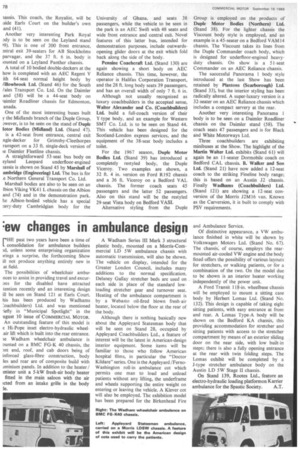'ew changes in ambulance design
Page 176

If you've noticed an error in this article please click here to report it so we can fix it.
r HE past two years have been a time of L consolidation for ambulance builders id, unless some enterprising organization wings a surprise, the forthcoming Show ill not produce anything entirely new in at field.
The possibilities of wheelchair amlairnces to assist in providing travel and excurans for the disabled have attracted tention recently and an interesting design ill be seen on Stand 121 at Earls Court. his has been produced by Wadhams :oachbuilders) Ltd. and was mentioned idly in "Municipal Spotlight" in the ugust 10 issue of COMMERCIAL MOTOR. An outstanding feature of this model is e Hi-Pope inset electro-hydraulic wheelair lift which is built into the rear entrance. ie Wadham wheelchair ambulance is punted on a BMC FG-K 40 chassis, the mit end, roof, and cab doors being of inforced glass-fibre construction, body les and rear are of composite build with minium panels. In addition to the heater / :mister unit a 5-kW fresh-air body heater fitted in the main saloon with the air Lcted from an intake grille in the body ie.
A Wadham Series HI Mark 3 structural plastic body, mounted on a Morris-Commercial LD 5W ambulance chassis with automatic transmission, will also be shown. The vehicle on display, intended for the Greater London Council, includes many additions to the normal specification. Delaney Gallay stretcher beds are used on each side in place of the standard lowloading stretcher gear and turnover seat. Heating of the ambulance compartment is by a Webasto oil-fired blown fresh-air heater, located below the floor at the rear of the body.
Although there is nothing basically new about the Appleyard Statesman body that will be seen on Stand 28, occupied by Appleyard Coachbuilders Ltd., a feature of interest will be the latest in American-design interior equipment. Some items will be familiar to those who follow American hospital films, in particular the "Doctor Kildare" series. One is the Appleyard /FernoWashington roll-in ambulance cot which permits one man to load and unload patients without any lifting, the underframe and wheels supporting the entire weight on entering or leaving the vehicle. A Klever cot will also be employed. The exhibition model has been prepared for the Birkenhead Fire and Ambulance Service.
Of distinctive appearance, a VW ambulance finished in white will be shown by Volkswagen Motors Ltd. (Stand No. 67). The chassis,' of course, employs the rearmounted air-cooled VW engine and the body fitted offers the possibility of various layouts for stretchers, or walking patients, or for a combination of the two. On the model due to be shown is an interior heater working independently of the power unit.
A Ford Transit 118-in, wheelbase chassis will be employed to mount a sitting case body by Herbert Lomas Ltd. (Stand No. 132). This design is capable of taking eight sitting patients, with easy entrance at front and rear. A Lomas Type-A body will be shown on the Bedford KA chassis, this providing accommodation for stretcher and sitting patients with access to the stretcher compartment by means of an exterior sliding door on the near side, with low built-in steps; there is also a fully opening entrance at the rear with twin folding steps. The Lomas exhibit will be completed by a J-type stretcher ambulance body on the Austin LD 5W Stage II chassis.
On Stand 139, Rootes Ltd., feature an electro-hydraulic loading platformon Karrier ambulance for the Spastic Society. A.T.




















































































































































































































































































